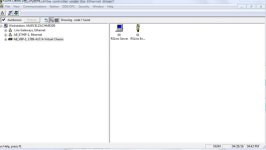Ethernet Firmware Flash - You must Disable BOOTP/DHCP!
samvivi7 said:
so i had to disabled my wifi and under TCP/IP(4) i had to set obtain IP automatically
then the correct MAC address of the processor showed up
i was able to set the IP address to the processor but wasnt able to disable the DCHP/BOOTP
i closed the BOOTP/DHCP program.
Restarted the PLC and set IP address, sub and gateway.
i no longer have a big red X on the PLC in RSLinx (i am assuming i good with communication).
But now its asking to update the firmware in Studio5000 when i try to go online
i will try to update the firmware and get back...
...i followed the firmware flash instructions and it seemed to have gone through as the Led went from flashing Red to Green. but i didnt get the update completed message at the end, instead the 100 seconds timed out.
Now i get the Red X on the processor in RSLinx. so i am back to where i started (not being able to go online with processor)
i tried BOOTP and setting the IP address but nothing (i see the MAC address and IP address next to it) i am still unable to disable the BOOTP/DHCP.
i have restarted the PLC couple of times.
I'm glad you got sorted but I'll post this anyway for your future sake and others...
When you initially used BOOTP Server to assign the IP address it would
NOT disable BOOTP/DHCP.
You then carried on and closed BOOTP Server.
You then restarted the PLC and set its IP address again.
You could then see it OK in RSLinx Classic under your Ethernet driver and all looked OK.
But, BOOTP/DHCP was still
NOT disabled.
You then tried to go online and were informed that you needed to flash the firmware.
You proceeded to do so through your assumed OK Ethernet connection.
Once the firmware flash got to "Polling for powerup" the processor rebooted and the IP address was lost because DHCP was still enabled.
The connection path for the firmware flash to finish was now lost.
When flashing these processors using Ethernet, you
MUST ensure that BOOTP/DHCP is disabled for the embedded Ethernet port, else the "Polling for power timeout" will occur.
BOOTP Server not disabling BOOTP/DHCP for devices is a common enough occurrence for users. I would advise you to connect to the processor using a USB cable and when you can see the processor under the USB CIP Driver in RSLinx Classic, right-click the processor and choose...
Module Configuration>
Port Configuration>
Static
This will assign a Static IP address to the processor i.e. disable BOOTP/DHCP.
Power cycle the controller and check the IP address has been retained by browsing for it using your Ethernet driver in RSLinx Classic. You could also check the Module Configuration again to be double sure.
Once you know the embedded Ethernet port has been assigned a Static IP address you can proceed to flash the firmware using Ethernet or alternatively you could use USB to flash it.
Flashing firmware using Ethernet is faster but comes with the above necessary steps to ensure a good flash.
Flashing firmware using USB is slower but does not require such steps.
Note: Even if flashing using USB, one can connect using USB and assign an initial Static Ethernet IP address and then proceed to flash the controller using USB. The Static IP address will be retained through the flash or any subsequent power cycles. This is because the embedded Ethernet port settings are saved in separate memory pertaining to the port and not in non-volatile memory.
The same can be said for the older CompactLogix Ethernet controllers such as the 1769-L32E and -L35E for retaining their IP address. Even if you power down and disconnect the battery, the controller will power up with the same IP address as before.
So, going forward, the best advice I can give here for Ethernet flashing is to use USB to set the initial Static IP address through RSLinx Classic and power cycle, checking its retained. Then proceed to flash the firmware through the Ethernet port.
All the other good advice above included, of course.
Regards,
George





